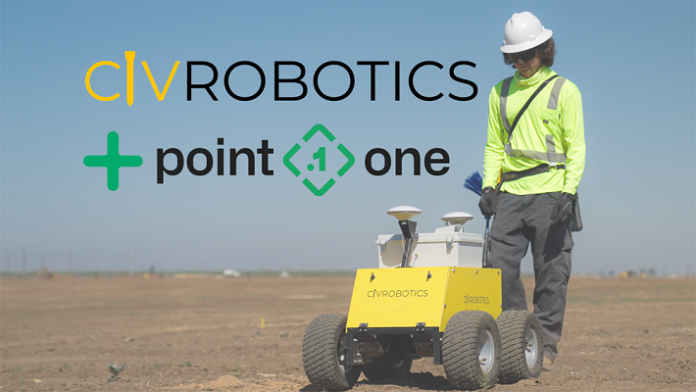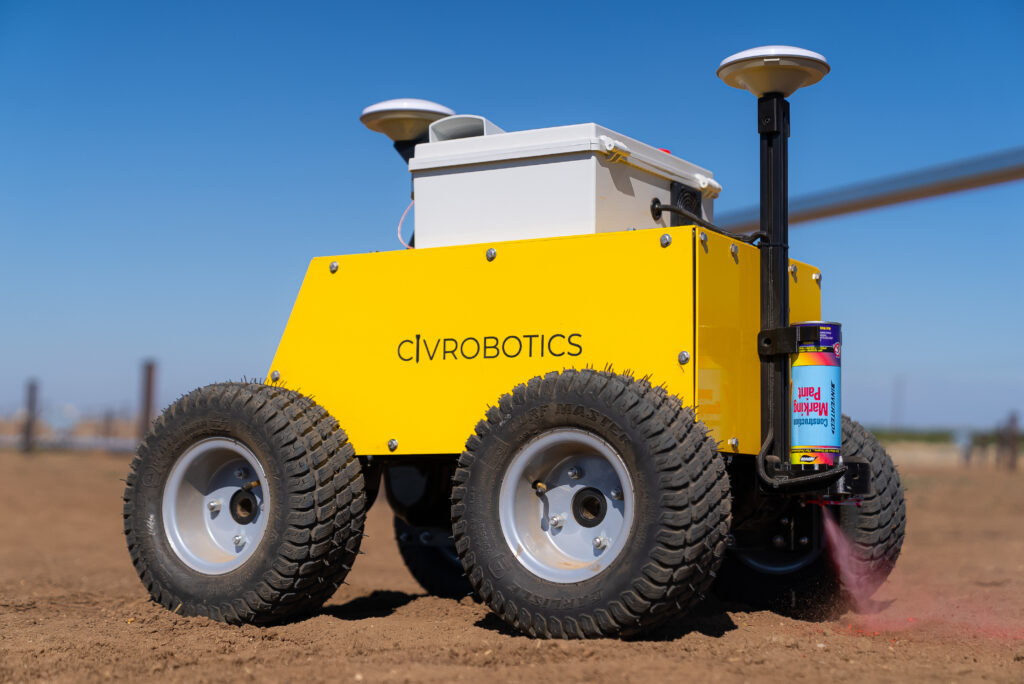
Bringing a construction project from planning on the page to execution in the real world is replete with challenges. Whether a company is building a sprawling solar farm or laying lines on the road, precision is paramount. Misfires of just a few inches can have massive implications, and that often leads to a plodding layout process. But, in partnership with Point One, Civ Robotics is ensuring that precise construction layouts won’t be at odds with efficiency.
In this case study, we speak with Liav Muler, the co-founder and chief operating officer of Civ Robotics, about how Point One has helped his company lower operating costs by streamlining processes for many of its high-precision layout projects.

About Civ Robotics
Land surveying is a critical stage in the construction layout process, during which workers use various forms of global navigation satellite systems (GNSS) to mark specific locations for builders.
“It’s kind of showing the blueprints in the real world,” said Muler.
Because this process demands a high degree of precision, any GNSS readings must be validated and corrected to ensure accuracy, sometimes within even a few centimeters. Historically, this work of verification and layout marking has been done by highly skilled workers manually carrying GPS tools to mark each construction spot, but Civ Robotics is out to change that.
Founded in 2018, the company aims to “revolutionize land surveying” with precision layout robots that anyone can operate. Leveraging Real-Time Kinematics (RTK), Civ’s rovers can translate construction plans to real-world layout markings that are accurate within less than a centimeter — and do it with speed. Where traditional surveyors would mark 200–450 coordinates per day, Civ operators can mark anywhere from 1,200–3,000 points in the same period.
Since bringing its products to market in 2021, Civ Robotics has expedited the land surveying process for dozens of clients in the industry, from solar farms to road construction companies.
Challenge: The High Costs of Precision
To ensure meticulous accuracy during surveying, Civ’s rovers typically connect to a base station through an RTK bridge. This process corrects any potential GNSS errors due to satellite clocks, atmospheric disturbances or other types of interference.
However, base stations are extremely expensive — a survey-grade station can run anywhere from $30,000 to $50,000. Each base station also requires Muler to be on site to set it up and calibrate it for the client. The costs are substantial, and the setup process is highly disruptive to Muler’s workflow.
Civ needed a way to get secure, reliable corrections via a simple, direct NTRIP mount point without the hassle of setting up its own base stations. An NTRIP setup would rely on its own network of RTK base stations, eliminating the need for Civ’s own installations.
“For me, having NTRIP is always easier than setting up a base,” said Muler. “It’s easy. It’s always working. There are no problems.”
Making RTK Corrections Easy
The challenge, though, was finding a partner with a sufficiently broad network of base stations for NTRIP coverage to meet his clients’ precision layout demands. Initially, Muler found a workable solution via an established vendor partner. He wasn’t actively looking for a replacement solution, but he wasn’t happy with the cost or the cumbersome process of creating new accounts with his existing vendor.
When he came across Point One at a trade show in Berlin, he was immediately drawn to the product thanks to its comparable precision, greater ease of setup and competitive pricing.
“It has a good distribution of base stations and good coverage,” he said. “Plus, the previous company we worked with was like two to four times as expensive, so for me it was a no-brainer.”
After a quick trial with one client, Civ Robotics was off and running with Point One for any project relying on NTRIP.
Solution: Point One Polaris
In Point One’s Polaris RTK Corrections Network, Muler found a broadly dispersed system of RTK base stations he could rely on consistently. With more than 1,400 base stations and 386,000 RTK correction devices across the U.S., Polaris delivers 99.9% network uptime with lightning-fast convergence times.
Not only that, but onboarding and setup were a breeze compared to Civ Robotics’ previous experience. New clients could get established almost instantly through the Point One web interface without any need for base station installations or complicated setup procedures.
“I can create accounts on the spot,” said Muler. “With our previous vendor, I would have to do a PO and then it would take like 48 hours before the account would be activated.”
Polaris also streamlines the process — and dramatically lowers the cost — of moving clients across state lines. Before, Muler would have paid for a new internet connection and port to set up an existing client’s rovers in a new state. With Point One, those costs are already baked in, saving the company fivefold on ongoing setup expenses.
“I think saving money and the simplicity of the product is a big benefit here,” he said. “Wherever I need an NTRIP, Point One is my go-to.”
To learn more about Civ Robotics, please visit https://www.civrobotics.com
To learn more about Point One Navigation and its products, visit: www.pointonenav.com.


















